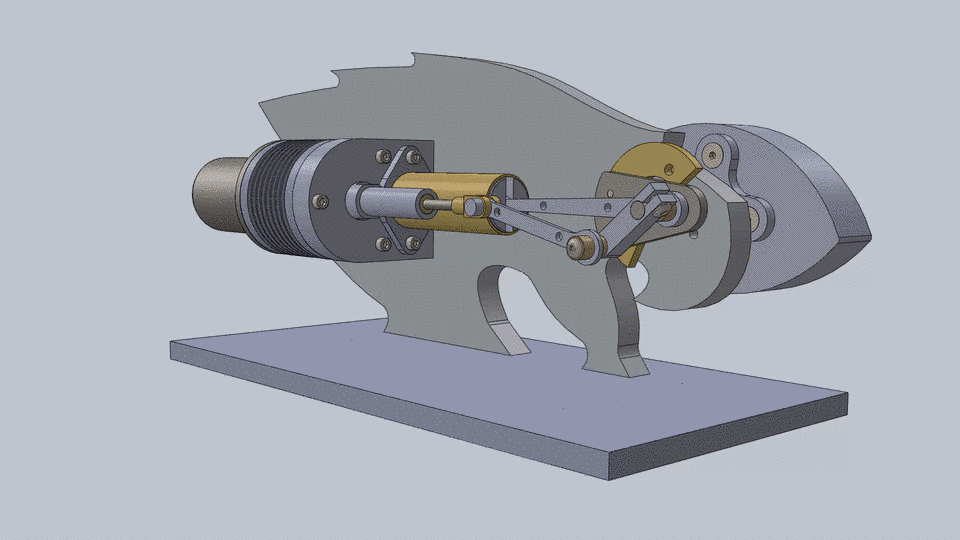Projects
Starting small with big aspirations
Giant Auto-drawing Digital Etch-a-Sketch
Inspired by my work at Deeplocal, I wanted to create a unique, delightful, analog-yet-digital piece for my new apartment. This super-sized Etch-a-Sketch is built around a wall-mounted TV and a Raspberry Pi coupled with stepper motors, a frame and shell assembly, three specially-designed circuit boards, and custom software. The knobs can be turned to draw on the screen just like a real Etch-a-Sketch, or an image can be uploaded so that the device draws it on its own. View CAD in OnShape. View code on Github. View build album.


Rapid-Prototyped Guitar
Inspired by my internship at Fender, I decided to make my own guitar from scratch. I used lasercut MDF and acrylic for the body, 3D-printed neck pieces, and a rectangular aluminum tube for support. Adding some purchased parts and some components from my old Epiphone made it fully functional. I then installed LEDs in the neck and developed a tuning program based on the M2 microcontroller that calculates the signal frequency and lights up the neck. View CAD in OnShape. View code on Github.
Longboard Design and Analysis
This is a 38" aluminum longboard deck I designed while taking courses in Statics and Manufacturing. I wanted to apply the knowledge I was learning in these classes to create a longboard that was strong and light. The "beams" of the board are thicker in the middle than on the edges, so bending stress is evenly distributed throughout the body. I was not allowed to machine it in Penn's shop, so I had it cut in a water jet machine. Simulations suggest the board can theoretically hold 1000 lbs.
3 Axis CNC router
In our final project for IPD 501, my team designed and manufactured a full 3 axis CNC router. This entailed choosing components, performing tolerance stackups, and considering manufacturability and assemblability for the larger parts. We incorporated some more advanced features into our design, such as a full tramming system. The machine is controlled using a TinyG and the Chilipeppr web interface. Our machine stayed within tolerance and budget while remaining easy to use.
Chess Board and Pieces
In Integrated CAD, CAM, and Analysis, my team and I made a full chess set. This involved using a CNC lathe to turn each piece and CNC mills for post-operations. As the lead designer and manufacturer for the board, I took inspiration from chess boards I had seen online and opted for a countoured surface with anodized aluminum tiles. A teammate suggested that we store the pieces in the board itself, so we drilled holes in the sides of the board. This was my first major woodworking project, and I learned a tremendous amount.

Eagles-Themed Heat Engine
For MEAM 201 Machine Design and Manufacturing, I made most of the parts in a previously designed Stirling engine. This required manual milling and turning as well as CNC work. In order to add my personal touch to the project, I made the engine Eagles themed. During testing, the engine achieved a speed of 850 RPM. View on GrabCad
Dissection and Modeling of a Nerf Blaster
As part of the "Dissect" assignment in Introduction to Mechanical Design (MEAM 101), my group fully dissasembled a Nerf Maverick blaster, modeled each part in SolidWorks, and created a full assembly followed by an explosion-collapse video. View on GrabCad
Hockey Playing Robots
For the final project in Design of Mechatronic Systems, my group created a team of autonomous hockey playing robots. These bots could search for a puck using IR light, navigate a rink using a constellation of stars above, and plan its driving path to the goal. View on Github
Injection Molded Guitar Capo
In IPD 501, we got the chance to try out a Morgan press and our injection molding skills. After making capo prototypes using 3D printing and urethane casting, we modified our design to include drafts and runners while developing a mold that could make both parts in one shot. This involved simulations to minimize sink and warping in the final products. After playing with the injection settings, we were able to churn out a capo every five minutes.
Four-Legged Research Robot
This is a robot I am building for Kodlab. I took an existing leg design and made a body that allowed for full range of motion while minimizing weight. In the future, I hope to test leaping capabilities, gait kinematics, and possibly alternate leg designs that are more flexible.
Vertical Axis Wind Turbine
As part of our junior design lab, my group designed, analyzed, and built a wind turbine. After creating a model and characterizing it in a wind tunnel, we scaled up our design and allowed the blades to telescope in and out. This kept the turbine compact during transport while maximizing power output. We generated 10.35 watts in our final test, finishing second in the class.
Desk Candy Space Shuttle
To learn about 3D and surface milling for IPD 501, I modeled and machined a small space shuttle. This involved developing a to-scale model of the orbiter, creating computer-generated toolpaths, preparing the aluminum stock, and running my Gcode programs. Because our shop's Haas MiniMill could not reach certain areas with a small endmill, I decided to create the vertical fin separately to allow for better tool access. In the future, I hope to turn the Shuttle's External Fuel Tank and Solid Rocket Boosters on a CNC lathe to complete the model.